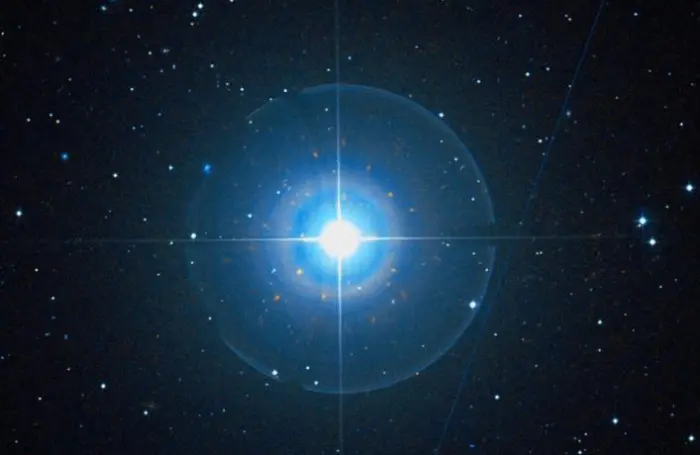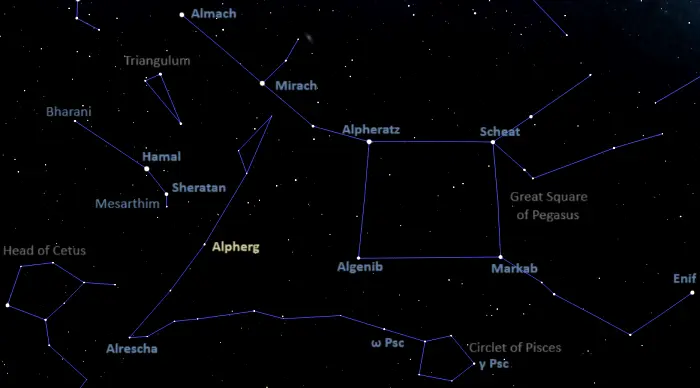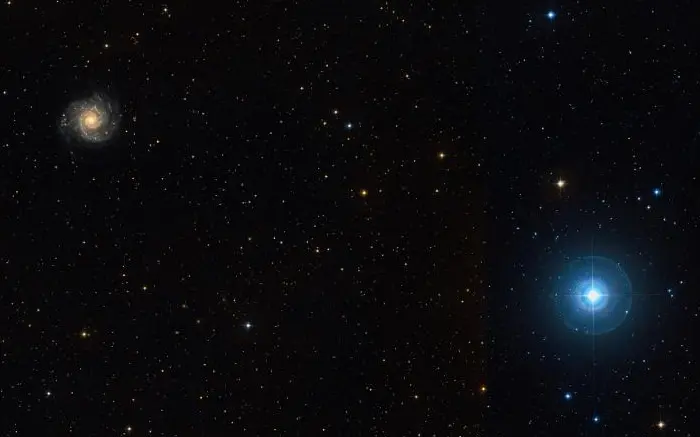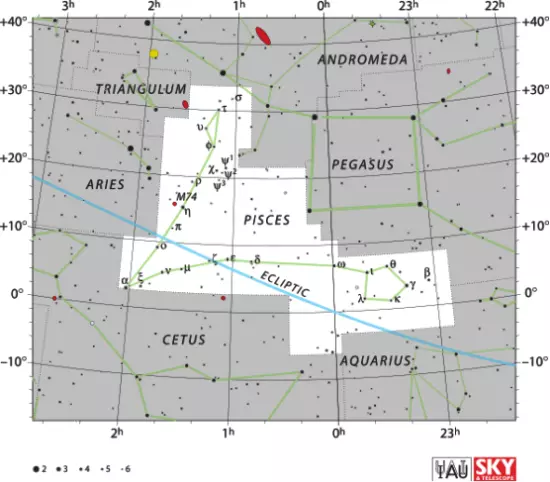Alpherg, Eta Piscium (η Psc), is a binary star system located approximately 350 light-years away in the zodiac constellation Pisces. With a combined apparent magnitude of 3.611, it is the constellation’s brightest star. It appears in the northern cord connecting the two fishes of Pisces, near the bright spiral galaxy Messier 74 (the Phantom Galaxy).
Star system
Eta Piscium is a double star composed of a yellow giant and a fainter companion. The two stars orbit each other with a period of 850.5 ± 66.5 years. The system has a semi-major axis of 1.228 ± 0.144 arcseconds and an eccentricity of 0.469 ± 0.053.
The brighter component, Eta Piscium A, has an apparent magnitude of 3.83. The companion star, Eta Piscium B, shines at magnitude 7.51.
The primary star, formally known as Alpherg, has the stellar classification G7 IIIa. It is a yellow giant star with a mass of 3.78 solar masses and a radius 26.48 times that of the Sun. With a surface temperature of 4,937 K, it is 457 times more luminous than the Sun. The star spins with a projected rotational velocity of 8.4 km/s. It has an estimated age of only 220 million years.

Alpherg (Eta Piscium), image: Wikisky
Alpherg is classified as a Gamma Cassiopeiae variable. Gamma Cassiopeiae stars show irregular variations in brightness because they have decretion disks that occasionally disappear or reform. Bright stars in this class include the prototype Gamma Cassiopeiae in the constellation Cassiopeia, Dschubba in Scorpius, Zeta Ophiuchi in Ophiuchus, Pleione in Taurus, and Gomeisa in Canis Minor.
Eta Piscium shows stable radial velocity variations with a period of 629 days, likely due to pulsations.
A 2014 study reported the detection of a weak magnetic field with a strength of 0.4 ± 0.2 G in the star. No X-ray emissions have been detected, which suggests that Alpherg is at the base of the red giant branch (RGB) phase.
Facts
Shining at magnitude 3.611, Alpherg does not make the list of the 300 brightest stars in the sky. At a distance of 350 light-years, the star’s light is diminished by interstellar dust by an extinction factor of 0.09 ± 0.06.
The binary nature of Eta Piscium was discovered by American amateur astronomer Sherburne Wesley Burnham in 1878. The system is catalogued as CCDM J01315+1521 in the Catalog of Components of Double and Multiple Stars (CCDM) and as WDS J01315+1521 in the Washington Double Star Catalog (WDS).
Name
The name Alpherg (pronunciation: /ˈælfɜːrɡ/) is derived from the Arabic al fargh, meaning “the emptying,” “the spout” or “the outpouring of water.” It was historically also spelled Al Pherg. The name was approved by the International Astronomical Union’s (IAU) Working Group on Star Names (WGSN) on June 1, 2018. It formally applies only to the primary component (Eta Piscium A) but has traditionally been used for the whole star system.
Eta Piscium was traditionally also known as Kullat Nunu (Kullat Nūnu). This was the name of the first ecliptic constellation in Neo-Babylonian astronomy. “Nūnu” was the Babylonian word for “fish” and “Kullat” referred to either the bucket or the cord that binds the fish.
In Chinese astronomy, Alpherg was known as 右更二 (Yòu Gèng èr), the Second Star of Official in Charge of the Pasturing. It was part of an asterism called Official in Charge of the Pasturing, which was also formed by Rho Piscium, Pi Piscium, Torcular (Omicron Piscium), and 104 Piscium. The asterism was part of the larger Bond mansion, which represented the body of the White Tiger.
Location
Alpherg is relatively easy to find but it requires clear, dark skies with little or no light pollution to be seen. It appears along the imaginary line extended from the brightest stars of Aries. Hamal and Sheratan are easily identified as the relatively bright stars below the chain formed by the three brightest stars of Andromeda (Alpheratz, Mirach and Almach), near the faint elongated triangle of the constellation Triangulum.
Alternatively, a line drawn from Markab through Algenib in the Great Square of Pegasus points in the general direction of Alpherg.

Alpherg location, image: Stellarium
Alpherg can be used to find the bright Phantom Galaxy (Messier 74), a face-on spiral galaxy located approximately 32 million light-years away. The galaxy lies only 1.5 degrees east-northeast of the star. It can be seen in small and medium telescopes, but it requires exceptionally good conditions.

Alpherg and Messier 74 (the Phantom Galaxy), image: Wikisky
Constellation
Alpherg is located in the constellation of Pisces. Representing the celestial Fish, Pisces is one of the 12 zodiac constellations, catalogued along with other ancient constellations by Claudius Ptolemy of Alexandria in his Almagest in the 2nd century CE. In Greek mythology, the constellation is associated with the story of Aphrodite and Eros jumping into the Euphrates River and transforming into fishes while fleeing from the monster Typhon.
Pisces is the 14th largest constellation in the sky. It stretches across 889 square degrees of the predominantly northern sky. It is one of the 15 equatorial constellations, visible from virtually anywhere on Earth for at least part of the year.

Pisces constellation map, image credit: IAU and Sky & Telescope magazine (Roger Sinnott & Rick Fienberg) (CC BY 3.0 DEED)
Even though it is large, Pisces is not very prominent in the sky because its stars are quite faint. The constellation hosts only two stars brighter than magnitude 4.0, Alpherg and Gamma Piscium.
Most of the brighter stars in Pisces are evolved subgiants and giants. These include the yellow giant Gamma Piscium, the orange giants Torcular (Omicron Piscium), Epsilon Piscium, and Theta Piscium, and the variable red giant 30 Piscium.
Other notable stars in Pisces include the variable Alrescha (Alpha Piscium), which connects the cords of Pisces, the hot blue star Fumalsamakah (Beta Piscium), which marks the mouth of the western fish, the variable red giant TX Piscium, the quintuple star system Zeta Piscium (Revati), and Van Maanen’s Star, the nearest known solitary white dwarf to the Sun.
Interesting deep sky objects in the constellation include the bright spiral galaxy Messier 74 (the Phantom Galaxy), the brightest member of the M74 Group, the spiral galaxy NGC 488, the pair of colliding spiral galaxies catalogued as NGC 520, the radio galaxy NGC 383, the galaxy cluster CL 0024+1654, and the Pisces Dwarf galaxy (Pisces I), an irregular dwarf galaxy in the Local Group. Pisces also hosts the Bullseye Galaxy (LEDA 1313424), a galaxy that has nine rings, more than any other known galaxy.
The best time of the year to observe Alpherg and other stars and deep sky objects in Pisces is during the month of November, when the constellation is higher above the horizon in the evening. The entire constellation is visible from locations north of the latitude 65° S.
The 10 brightest stars in Pisces are Alpherg (Eta Psc, mag. 3.611), Gamma Piscium (mag. 3.699), Omega Piscium (mag. 4.01), Iota Piscium (mag. 4.13), Torcular (Omicron Psc, mag. 4.27), Epsilon Piscium (mag. 4.27), Theta Piscium (mag. 4.27), Alrescha (Alpha Psc, mag. 4.33), 30 Piscium (mag. 4.31 – 4.41), and Fumalsamakah (Beta Psc, mag. 4.40).
Alpherg – Eta Piscium
| Spectral class | G7 IIIa |
| Variable type | Gamma Cassiopeiae |
| U-B colour index | +0.730 |
| B-V colour index | +0.976 |
| Apparent magnitude | 3.611 (3.83 + 7.51) |
| Absolute magnitude | −1.52 |
| Distance | 350 ± 30 light-years (107 ± 8 parsecs) |
| Parallax | 8.7335 ± 0.9207 mas |
| Radial velocity | 13.60 ± 0.42 km/s |
| Proper motion | RA: +28.584 ± 0.613 mas/yr |
| Dec.: -3.217 ± 0.376 mas/yr | |
| Mass (η Psc A) | 3.78 ± 0.16 M☉ |
| Luminosity (η Psc A) | 457 L☉ |
| Radius (η Psc A) | 26.48 ± 2.15 R☉ |
| Temperature (η Psc A) | 4,937 ± 40 K |
| Metallicity (η Psc A) | −0.13 ± 0.06 dex |
| Age (η Psc A) | 220 ± 30 million years |
| Rotational velocity (η Psc A) | 8.4 km/s |
| Surface gravity (η Psc A) | 2.20 ± 0.14 cgs |
| Constellation | Pisces |
| Right ascension | 01h 31m 29.0081880156s |
| Declination | +15° 20′ 44.994632991″ |
| Names and designations | Alpherg, Eta Piscium, η Psc, 99 Piscium, Kullat Nunu, HD 9270, HR 437, HIP 7097, SAO 92484, FK5 50, BD+14° 231, AG+15 131, GC 1839, GCRV 861, PLX 314.00, PPM 117418, GSC 01198-01597, NSV 532, JP11 504, PMC 90-93 35, UBV 1589, 2MASS J01312901+1520452, TYC 1198-1597-1, Gaia DR2 2591891443195389696, Gaia DR3 2591891443195067264, ADS 1199 A, CCDM J01315+1521A, IDS 01261+1450 A, WDS J01315+1521A |